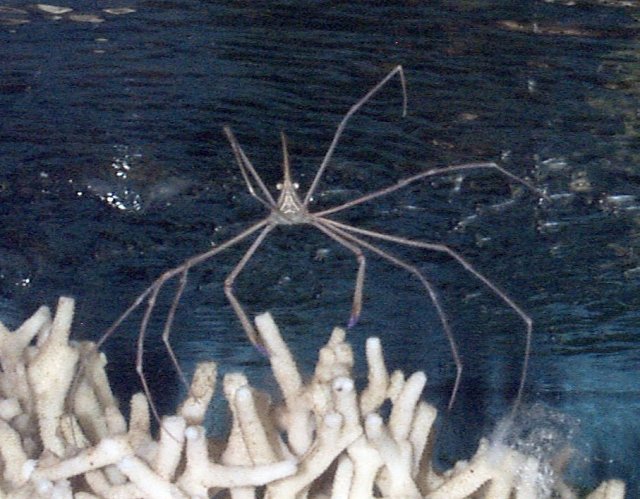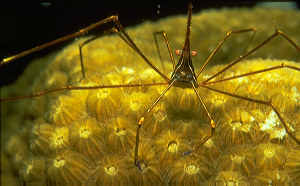
The Arrow Crab has eight spider-like legs and has a head that is exceptionally pointed at the tip. The legs of an Arrow Crab can be more than three times its body length. The body of an Arrow Crab is composed of many colors. The whole body is covered in a golden-brown color, with white, brown, or gold stripes running along the crab's body. The ends of the legs are dark violet. As the Arrow Crab grows it will shed an outer layer of its skin called the exoskeleton.
The Arrow Crab is a nocturnal creature, meaning that it does most of its daily responsibilities at night time. The crab will do all of its scavenging during the night time. Since the Arrow Crab is nocturnal, it is rarely seen out during the daylight hours. These crabs do not fear divers who want to come and take pictures of it, but when it comes to other animals, even its own species, the Arrow Crab can be quite territorial.

Steve Norvich http://underwaterphotos.com/GPhoto6.htm
In the course of mating, the male Arrow Crab will hold the female Arrow Crab against his belly so that he can place a sperm packet into the female. Once the female has been fertilized she will carry her eggs underneath her abdomen until the eggs are ready to hatch. The babies that emerge are called zoea, and once they are born they swim towards the surface of the ocean and feed on small plankton. As the young Arrow Crab continues to grow it will shed its exoskeleton and will replace it with a new one. It will continue to do this until the crab has reached its maximum size.
Currently not on exhibit.

Fabio Ehrengruber http://www.wgn.net/~fabio/gallery/bonaire3.htm
Emilio Barela
flaco_chico@hotmail.com
Sources and Links:
Meinkoth, Norman A. National Audubon Society Field Guide to North
American Seashore. "Arrow Crab". pg. 66.
Block, Melissa. The University of Michigan.
" Stenorhynchus seticornis. Yellowline
Arrow Crab".
http://animaldiversity.ummz.umich.edu/accounts/
stenorhynchus/s._seticornis$narrative.html
Sea Frontiers. "The Arrow Crab: A Spindly Crawler". Spetember-October 1989. pg.303
Wrenbird's Reef Tank. "Arrow Crab". http://www.lakehouse.com/aquarium/arrowcrab.htm